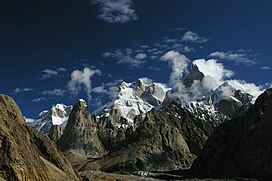Latok, Pakistan
Appearance
| Latok I لیٹوک | |
|---|---|
 Latok Peaks and the Ogres thumb | |
| Highest point | |
| Elevation | 7,145 m (23,442 ft)[1] |
| Prominence | 1,475 m (4,839 ft)[1] |
| Coordinates | 35°55′41″N 75°49′21″E / 35.9280°N 75.8225°E |
| Geography | |
Location of the Latok within the greater Karakoram region | |
| Location | Gilgit-Baltistan, Pakistan |
| Parent range | Panmah Muztagh, Karakoram |
| Climbing | |
| First ascent | July 19, 1979 by Sin'e Matsumi, Tsuneo Shigehiro, Yu Watanabe[2] |
| Easiest route | East Ridge from south side |
 | |
The Latok (
Urdu: لیٹوک) group is a cluster of large and dramatic rock peaks in the Panmah Muztagh, part of the central Karakoram mountain range in Pakistan. They lie just to the east of the Ogre group, dominated by Baintha Brakk. To the immediate south of the Latok group lies the Baintha Lukpar Glacier, a small tributary of the Biafo Glacier
, one of the main glaciers of the Karakoram. On the north side, lies the Choktoi Glacier.
Latok group
The Latok group comprises four main summits, each listed here with its relative position in the group, elevation,[1] and first ascent date:
- Latok I, north-central, 7,145 m, climbed 1979
- Latok II, west, 7,108 m, climbed 1977
- Latok III, east, 6,949 m, climbed 1979
- Latok IV, southeast, 6,456 m, climbed 1980
Climbing history
All of the summits are notable for their extreme technical difficulty, and they have been the scene of some of the hardest climbing done at high altitude anywhere in the world.
- First attempt on the North Ridge of Latok I: The North Ridge was first attempted in 1978 by an American expedition consisting of George Lowe came within a few pitches of the summit. This climb and successful retreat has fueled continued interest in the mountain.[3]
- First Ascent of Latok I: Latok I was first climbed in 1979 by a Japanese expedition led by Naoki Takada; the first summit party comprised Sin'e Matsumi, Tsuneo Shigehiro, Yu Watanabe, and they were followed three days later by Hideo Muto, Jun'ichi Oku, and Kota Endo. They started from the Baintha Lukpar Glacier and climbed a buttress to reach the East Ridge. The steep North Ridge of Latok I, 2,500 m (8,200 ft) high, has not yet been climbed in its entirety.[4]
| Latok II | |
|---|---|
| Highest point | |
Northern Areas, Pakistan | |
| Parent range | Panmah Muztagh, Karakoram |
| Climbing | |
| First ascent | 1977 by Ezio Alimonta, Toni Masé, Renato Valentini[5] |
| Easiest route | Southeast Buttress |
- First Ascent of Latok II: Latok II saw its first ascent in 1977, by an Italian group led by Arturo Bergamaschi. (This was the first successful ascent in the group.) They climbed the southeast face of the peak, and Ezio Alimonta, Toni Masé and Renato Valentini made the summit.[5]
| Latok III | |
|---|---|
| Highest point | |
Northern Areas, Pakistan | |
| Parent range | Panmah Muztagh, Karakoram |
| Climbing | |
| First ascent | July 15, 1979 by Yoji Teranishi, Kazushige Takami, Sakae Mori[2] |
| Easiest route | Southwest Ridge |
- First Ascent of Latok III: The first ascent of Latok III came in 1979, by a Japanese team under the leadership of Yoji Teranishi. They climbed the Southwest Ridge, and the summit party were Teranishi, Kazushige Takami, and Sakae Mori.[2] The second ascent, via the same route, came in 1988, by an Italian party. This was the first repeat ascent of any peak in the group.[6]
- 1997 Expedition on Latok II: A notable next ascent of Latok II came in 1997, when a very strong team composed of Denali": a 1,000 m (3,300 ft) vertical rock wall with a base at 6,100 m (20,000 ft) elevation. The total vertical for the climb was 2,200 m (7,200 ft).[7]
- 2018 Accident on Latok I : On 31 July 2018, the
- First Ascent of Latok I through the North Face: Slovenian climbers Aleš Česen (36), Luka Stražar (29) and British climber Tom Livingstone (27) climbed three-quarters via North Ridge of Latok I (7145m) before traversing the West side and summiting through the original route on 9 August 2018. They made the second ever ascent on the mountain after 1979.[11]
- First Ascent of North Ridge: Russian climbers Alexander Gukov (42) and Sergey Glazunov (26) left on July 15 to climb Latok I via the unclimbed North Ridge. They managed to climb to the top of North Ridge, but failed to reach the summit of Latok I. During the descent, Glazunov fell to his death and Gukov was stranded for 7 days in bivouac on the ridge. He was eventually rescued by helicopter.[citation needed]
References
- ^ a b c d e Heights in this article are taken from the map Karakoram, 1:250,000, Swiss Foundation for Alpine Research. A survey under the leadership of Professor Arturo Bergamaschi gives the heights as follows:
- Latok I: 7,086 m
- Latok II: 7,151 m
- Latok III: 6,860 m
- ^ a b c American Alpine Journal, 1980, 647-648
- ^ "Latok I Climbed from the North, but North Ridge Remains Incomplete". 14 August 2018.
- ISSN 0307-1235. Retrieved 2018-08-21.
- ^ ISBN 0-89886-238-8
- ISBN 0-340-64931-3
- ^ American Alpine Journal, 1998, 34-43
- ^ "Pak Army rescued a Russian Climber from Latok on 31 July, 2018". The Express Tribune. Retrieved 1 August 2018.
- ^ "Major General Asif Ghafoor's Tweet". Twitter.com. Retrieved 1 August 2018.
- ^ "Pakistani pilots pull off daring rescue". dreamwanderlust.com. 6 August 2018.
- ^ "Latok I keeps on surprising this summer; climbed after 1979". dreamwanderlust.com. 23 August 2018.


